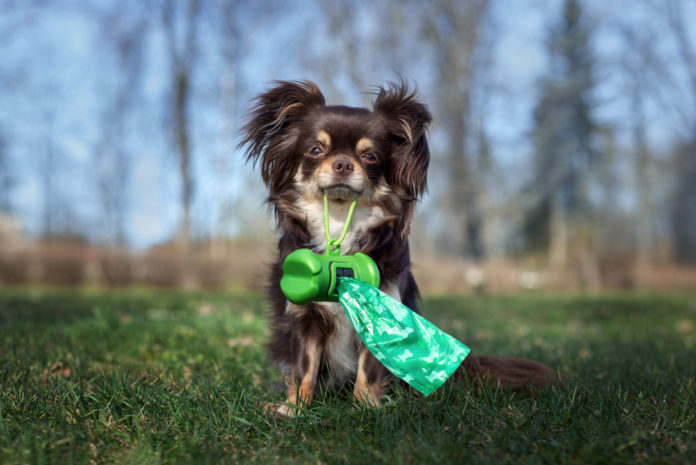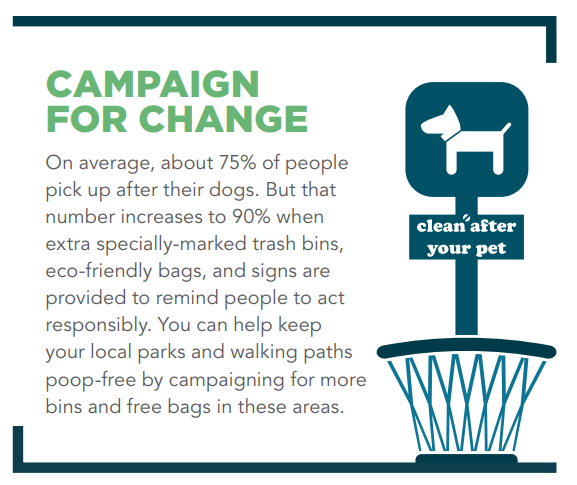Earth-friendly pet waste disposal

What goes in, must come out…and that means finding safe, earth-friendly ways to dispose of pet waste. Here are some options.
The cost of living with a dog or cat is often calculated in dollars. Veterinary care, food, toys, bedding, and training all factor into the bottom line. There’s another cost that’s harder to pinpoint but is equally important — the environmental impact of pet waste. In other words, poop is a big problem for the planet. Let’s look at some ways to dispose of your pet waste while keeping the Earth’s well-being in mind.
What’s the big deal?
In 2019, a pet waste removal company named Doody Calls reported that the 84 million dogs living in the United States produced 11.6 million tons of poop, enough to fill 300,000 18-wheelers – enough trucks to stretch from New York to Los Angeles! To make matters worse, most dog poop is disposed of in plastic bags.
Additionally, dog waste carries parasites that can lead to Salmonella, E coli, and other worms and diseases that can spread to humans. It’s estimated that 20% of bacteria in waterways can be traced back to dog waste that was improperly handled or simply left where it was deposited.
As for cats, thousands of tons of traditional clay clumping litters end up in landfills each year. So you can see the problem. The question is, what can we do about it, and what are the most eco-friendly ways to dispose of dog poo and used cat litter?
Picking up poop
Whether we’re walking our dogs around the neighborhood or along a nature trail, it’s important to pick up after them. Typically, a plastic bag over the hand is a convenient way to pick up dog excrement; turning the bag inside out before tying it up and throwing it away means your hands don’t have to come into contact with the mess. The problem is, plastic doesn’t biodegrade, especially in landfill settings where no air reaches the layers of trash and garbage. Using a bag for pickup and dumping only the contents into the trash bin still leaves a soiled bag that has to be disposed of.
Alternatives to plastic bags
- An alternative to plastic bags is a pooper scooper, such as you’d use to clean out a litter box; or a long-handled scoop with a hinged pan, of the type used for trash pickup. The problem is, you still have to carry the poop to a garbage receptacle, so while this might be a good option for the backyard, it’s not very practical on a long hike.
- Look for poop bags made from vegetable starches, approved by the Biodegradable Products Institute (BPI), that meet the ASTM D6400 guidelines for composting, and that come in packaging made from or containing recycled materials. Some manufacturers that claim their bags are biodegradable may technically be telling the truth, but they don’t say how long it takes for the bags to break down. Plant-based bags are biodegradable and compostable.
- Another plastic bag alternative is newspaper, which can break down in as little as six weeks in the open air. It takes longer in a landfill, but not nearly as long as plastic. Brown paper bags are another option. Just keep in mind that paper comes from trees, so recycle paper bags rather than buying them new.
What about burying it?
When you’re out in nature, it may seem natural to just bury your dog’s waste and leave it there. But feces from domestic dogs can endanger wildlife. “In one year, 65% of the wolf pups born in Yellowstone National Park died,” states Stephanie Feldstein, Population and Sustainability Director at the Center for Biological Diversity, in a 2006 article published in The New York Times. “Biologists suspected canine parvovirus, perhaps brought in by a tourist’s dog. Parvo lives in the soil for months. Simply sniffing the ground can lead to infection. In backcountry treks with dogs, it’s best to carry waste out with you.”
Flush it down
“The EPA recommends flushing dog poo unless you have a septic tank,” says Feldstein. Call your local water department to verify they can effectively treat dog waste. “Never flush cat litter. The clumping action that makes cleanup easy will clog pipes and lead to costly plumbing repairs.”
“Traditional, clay-based cat litter’s bad for the planet, as its mining destroys ecosystems, pollutes waterways, and more.”
 Cat litters – stay away from traditional clay
Cat litters – stay away from traditional clay
“Traditional, clay-based cat litter’s bad for the planet, as its mining destroys ecosystems, pollutes waterways, and more,” says Stephanie Seferian, creator and host of The Sustainable Minimalists podcast. “Opt for a natural cat litter instead, such as pine pellets. I also have a special, lidded trash can solely for soiled pine litter, no plastic bag needed.”
Cat litters come in a huge variety of materials now, including previously discarded by-products of corn, wheat, pecans, and walnuts, to pine, sawdust, and grasses. Most are low in dust, have a pleasant aroma, and are affordable and easy to use.
Feces from domestic dogs can endanger wildlife.
Feed him a better quality diet
Another way dogs and cats affect the environment is by the food they eat. What goes in their mouths will eventually exit from the tail end. A high quality whole foods diet free of synthetic additives means fewer chemicals ending up in the environment from their waste. As well, the better the food is in quality, the less your animal needs to eat to feel full; and a food that doesn’t contain a lot of cheap fillers means the volume of his stools will be lower.
New study shows that quality dog food means less poop to scoop
A new University of Illinois comparison study published in the Journal of Animal Science shows that dog food diets made with human-grade ingredients are not only highly palatable, they’re also extremely digestible. And that means less poop to scoop — up to 66% less!
Kelly Swanson, a professor in the Department of Animal Sciences at the College of Agricultural, Consumer & Environmental Sciences at the university, and his team fed dogs four diets — a standard extruded dog kibble; a fresh, refrigerated diet; and two fresh diets made using only USDA-certified human-grade ingredients. These fresh diets included minimally-processed ingredients such as beef, chicken, rice, carrots, and broccoli. The dogs consumed each diet for four weeks.
The researchers found that dogs fed the extruded diet had to eat more to maintain their body weight, and produced 1.5 to 2.9 times as much poop as the dogs on the fresh diets.
The researchers also found that the fresh diets uniquely influenced the gut microbial community. “Because a healthy gut means a healthy [dog], fecal microbial and metabolite profiles are important readouts of diet assessment,” Swanson says. “As we have shown in previous studies, the fecal microbial communities of healthy dogs fed fresh diets were different than those fed kibble. These unique microbial profiles were likely due to differences in diet processing, ingredient source, and the concentration and type of dietary fibers, proteins, and fats that are known to influence what is digested by the dog and what reaches the colon for fermentation.”
While we obviously can’t do away with dog and cat waste entirely, there are things we can do to lessen its impact on our natural environment. Proper cleanup and disposal, using products that are as earth-friendly as possible, while feeding your dog or cat a good quality diet made from natural ingredients, are the best options.



